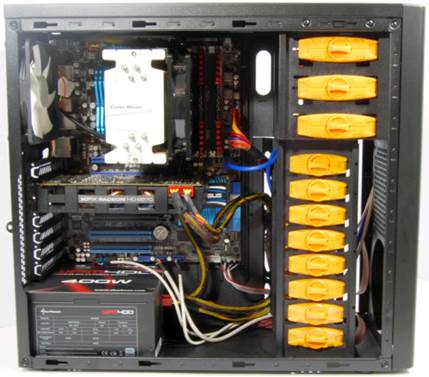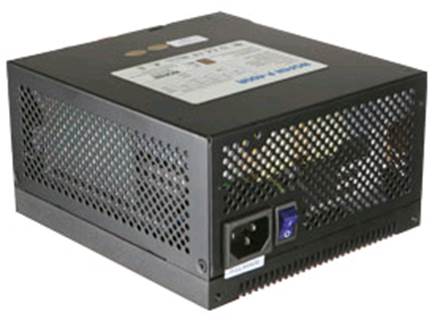If your PC sounds more like an
aircraft taking off than a piece of precision technology, join us for aural
tranquility
PCs require maintenance to keep them
performing at an optimum level. Over time, parts wear out, screws work their
way loose, and dust accumulates inside the case. A noticeable side effect is
increased noise. When new, your PC may have been a monument to mechanical
efficiency and whisper-quiet operation; a few short years later, it likely sounds
more like a diesel generator.
So, what can be done to quieten the
constant racket emanating from below the desk? Wrapping the case in a blanket
or surrounding it with cushions might dampen the noise, but a PC requires good
airflow to avoid cooking the internal components.
Moving the unit into a cupboard will garner
the same results - and it’s impractical. Thankfully, there are easier and less
destructive ways of minimising sonic emissions.
One thing to check before you begin is
whether the PC’s Bios settings allow you to control the fan speed.
Look in the Bios (usually accessible by
pressing F1 or Del during bootup) for an H/W Monitor section. If there’s an
option here along the lines of ‘CPU Smart Fan Target’, you’ll be able to
specify the maximum temperature that the CPU is allowed to reach. We recommend
you select a temperature below 60°C. Save and reboot.
A wealth of quiet fans, power supplies, CPU
coolers, cases and soundproofing kits are available online from sites such as
quietpc.com. These will be the perfect aid in your quest for aural tranquility.
Quiet upgrades are easy to administer, but
can make a big difference to the operation of your computer. If one of your
fans is particularly boisterous, you can replace it with a super-quiet
alternative. And if the power supply is whining like a dentist’s drill, perhaps
it’s time to plump for a quiet-fanned model.
In the following guide, we show you what
types of quiet kit are available. We also explain how you can make a few small,
low-cost tweaks that will go a long way in silencing a noisy PC.
Choose quiet kit
The first thing to determine when tackling
a noisy PC is which parts are responsible for the racket. A few simple tests
will enable you to identify the troublesome component(s). A basic rule, though,
is that any component with moving parts is a likely suspect.
Fans
In many cases it’s the PC’s fan(s) at the
heart of the problem. To find out which fan is responsible for the noise, power
off the machine, open the case, then hold a pencil or other thin, non-metal
item between a fan’s spokes to prevent it spinning. Now power on the machine
and see whether stopping the fan has an effect on the level of noise. If it’s
still just as loud, try the same trick with each of the other fans fitted
inside the case in a process of elimination. Remember that CPU coolers,
graphics cards and power supplies usually have their own fans, too.

AcoustiFan
DustProof
Bigger fans spinning slower than their
smaller siblings can move the same volume of air, so buying a larger fan can
reduce noise. To make things quieter still, the 120mm AcoustiFan DustProof $26,
tinyurl.com/d3hz8ku) has a sealed motor to prevent dust clogging up the
mechanics and reduce noise.
If you’re a gamer, you’ll need a
high-performance fan such as the 120mm Scythe Gentle Typhoon ($26,
tinyurl.com/cvogLt8). It won’t be completely silent, but Scythe has implemented
various vibration-reduction techniques to lessen the fan’s audible impact. Be
sure to measure the size of your existing fans before making a purchase;
typically they’ll be either 80mm, 92mm or 120mm.
Apple recently announced a new asymmetric
fan design for the MacBook Pro. Here, the frequency range is increased by
breaking up the regularity of the fan blades. In theory, this should replace a
constant hum with a dissipated sound.
Fans can be almost entirely avoided if you
go down the water-cooling route. This gets expensive very quickly, mind. You
can read our walkthrough on liquid-cooling your CPU at tinyurl.com/c4zej82.
Another option is to buy an oversized
‘passive’ heatsink for your processor, and a graphics card with a similar
passive cooler. However, you’ll still need one or two fans fitted inside the
case to keep air moving over these heatsinks.
Optical drives
Discs spinning at speed can spoil your
enjoyment of a movie. Speed-limiting software, such as CD-Bremse
(tinyurl.com/cvc5wop) and Nero CD-DVD Speed (tinyurl.com/2wxrpzp) can aid older
models, while newer optical drives such as the LG BH10LS38 ($111, tinyurl.com
/aL6ty64) have onboard software that automatically adjusts the spin speed in
relation to the task at hand.

LG
BH10LS38
Cases
Although cases have no moving parts,
cheaply made models can rattle in use. With the vibrations created by spinning
drives and fans already driving you to distraction, the last thing you need is
the system case adding its creaks to the chorus. A badly ventilated case can
also cause the internal temperature to rise, thus requiring the dreaded fans to
spin up to maximum speed.
Noise-reducing cases tend to employ
higher-quality components in their construction, with sound-deadening material
and softer feet on the bottom to reduce the transference of vibrations to the
ground.
A good example of a reasonably priced quiet
case is the Nexus Thrio 310 ($60, tlnyurl.com/cqbc5nk). The interior is lined
with noise-absorbing material, various bumpers stop rattles, and you can even
mount the power supply unit upside down to expel the hot air it generates
straight out the case.

Nexus
Thrio 310
For those with bigger budgets, the NoFan
CS-70 system case ($269, tinyurl.com/bece2m2) is designed to eschew fans and
promote natural convection cooling. The only snag is that it will accept only
MicroATX motherboards. The less attractive CS-80 ($134, tinyurl.com/brqkL4x)
will take a full-size ATX board.
Hard drives
Hard drives are slowly being replaced by
their silent brethren, solid-state drives (SSDs). It’s still early days for
this technology, so SSD prices remain comparatively high, but increasingly
we’re seeing PCs that install the OS on a small SSD (such as the Crucial 64GB
m4, $90, tinyurl.com/cnktnao) and then use the a cheaper hard disk for mass
storage. This gives you a nice performance hike, minimises the use of noisy
hard disks, and the drives run cooler, so there’s less demand for fans to spin
into action. SSDs also enable Windows to feel far more responsive, with faster
startup and shutdown times.

Crucial
64GB m4
CPU coolers
When choosing a new processor cooler, be
aware that some require access to the underside of the motherboard, and their
fitting is a far more involved job than it is with those that attach to the
top. Also be sure to select a model that matches your processor’s socket type;
Quiet PC marks all the products it sells with the relevant socket type, and offers
a helpful guide to choosing a CPU cooler at tinyurl.com/autbun8.

Siberian
Quiet
Models range from the cheap and cheerful
Siberian Quiet ($11, tinyurl.com/aup8wco), which is designed for small-chassis
machines, to the NoFan CR-95C IcePipe ($141, tinyurl.com/bdw6pk2), which is
completely fanless and suited to Intel third-generation Core processors (aka
Ivy Bridge).
Graphics cards
Graphics cards do some serious work and
therefore need plenty of cooling. In other words, they can make a right old
din. Manufacturers such as HIS and Gigabyte offer specially designed quiet
models. An example is the Gigabyte nVidia GeForce GTX 660 Ti Windforce ($378,
tinyurl.com/c4p2st9).

Gigabyte
nVidia GeForce GTX 660 Ti Windforce
If you don’t want to change your graphics
card, instead consider adding a quieter fan. The Arctic Cooling Accelero
Extreme GTX Pro ($50, tinyurl.com/bL8sne4) is a quiet cooler for nVidia GTX
graphics cards, while the Gelid Solutions Icy Vision Rev 2 ($48, tinyurl.com/boxcr7s)
works well with a range of AMD and nVidia cards.
PSUs
Don’t even contemplate opening up your PSU
to replace its fan. You’ll need to exchange the entire unit for a silent
version, of which several options are available.

NoFan
P400-A
If your computing demands aren’t
particularly intensive, but your need for silence is utmost, opt for something
like the NoFan P400-A ($218, tinyurl.com/aoyn3oo). Gamers should look to models
such as the AeroCool Strike-X ($74, tinyurl.com/azgm7Lf), which offers 600W of
power and has a quiet 139mm fan and a striking design. Those who just want a
simple, affordable PSU for everyday use would appreciate the Zalman GS-500w
($60, tinyurl.com/cs6ywcz), which is a fine budget model.
Fan controllers
If your Bios doesn’t allow you to tweak the
fan speed, another manipulation method is offered by a fan controller. These
devices allow you to monitor and adjust the RPM of each connected fan, and let
you keep an eye on the internal temperature of your machine.

The
Scythe Kaze-Master
The Scythe Kaze-Master ($59,
tinyurl.com/atfdoqo) fits in an optical drive bay and offers control over up to
four fans. It also notes the spin speeds and internal temperatures on a
built-in LCD.
If you don’t want to go down the hardware
route, a solid software solution is the free SpeedFan (almlco.com). As well as
allowing you to control your PC’s fan speeds, SpeedFan can also cleverly read
the temperature sensors that are built into the motherboard/processor.